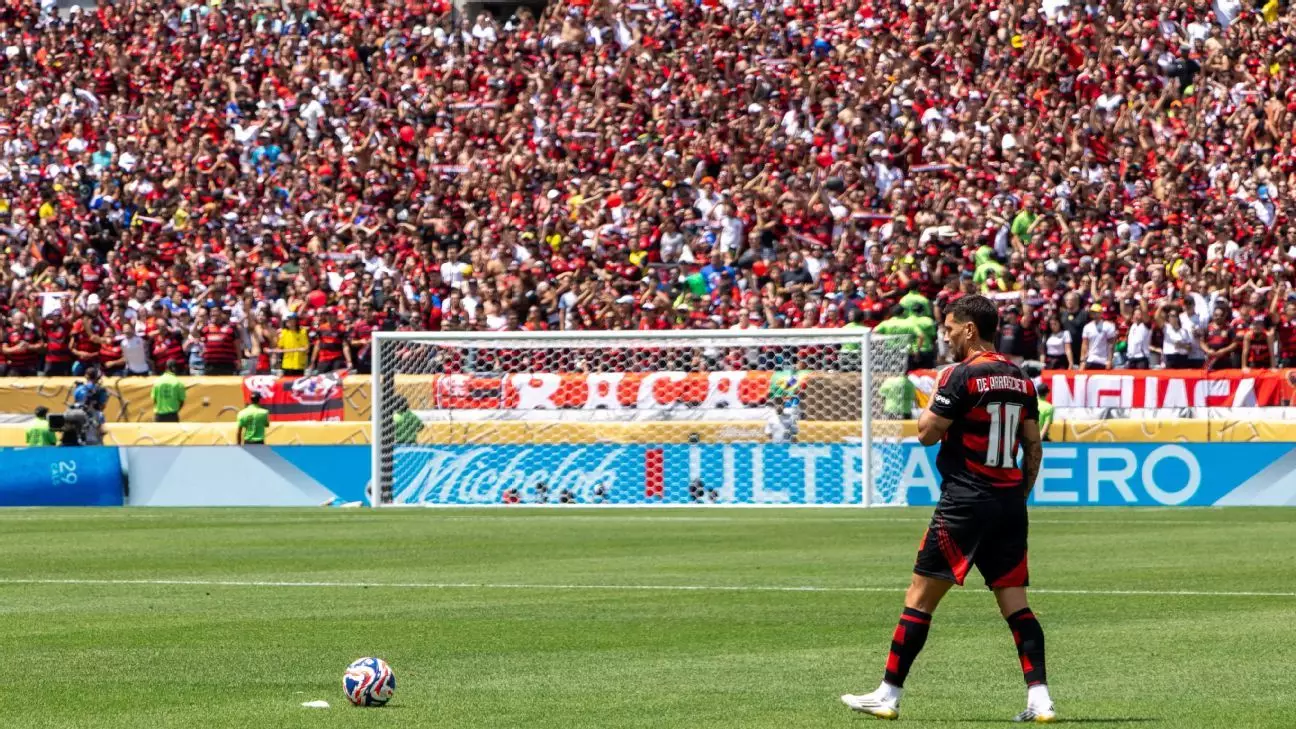The FIFA Club World Cup, reimagined as a 32-team format, brings forth an exhilarating opportunity for teams worldwide to showcase their talent on a global stage. As the tournament unfolds, Brazil has expressed its desire to host the next edition in 2029, and it’s hard to ignore the sense of inevitability surrounding this prospect. Amidst grand ambitions, however, the inaugural tournament thus far has faced significant challenges, including sparse attendance, sporadic weather interruptions, and the sweltering summer heat that threatens player endurance in the knockout rounds. The question looms: is this a tournament finding its footing, or is it precariously hanging in the balance?
Yet, amidst this turbulence, the South American contingent has emerged as the tournament’s heartbeat. Fans from Brazil and Argentina have descended upon U.S. shores, instilling a raw energy into the competition. Their relentless spirit acts as both a rallying cry and a reminder to skeptics that, indeed, this event carries weight. Without these supporters, the competition might have flirted dangerously with irrelevance. The fireworks of passion have been ignited, and the South American pride is palpable. As the group phase approaches its conclusion, the results have largely vindicated their raucous enthusiasm, with almost all Brazilian representatives showing their might.
The Underdog Story: Unexpected Triumphs and Expected Contenders
This year’s tournament has seen surprise victories that have rewritten expectations. Few anticipated Botafogo’s stunning defeat of Paris Saint-Germain, while Fluminense has also managed to defy the odds, carving out a reputation as a formidable competitor. On the other hand, the more seasoned teams, Flamengo and Palmeiras, are largely fulfilling their anticipated roles, steadfastly aiming for the title. This dichotomy highlights the unpredictability inherent in knockout football—as the ambitious underdogs clash with seasoned giants.
The ethos surrounding this revitalized tournament reflects South America’s fervor for football. Historically, the continent has sought to prove itself on a stage dominated by European powerhouses, with the Copa Libertadores serving as the battleground from which these aspirations emerged. The genesis of this tournament was meant to channel that competitive spirit into a contest against the best Europe has to offer. For too long, South American teams have struggled in the Intercontinental Cup, often falling short despite their passionate investment in these encounters. With conditions now seemingly favoring them—firmly in mid-season form as opposed to Europe’s burnt-out squads—South American clubs might just be on the cusp of a breakthrough.
Flamengo: A Team of Resilience
Flamengo’s journey has been marked by a rollercoaster of highs and lows. Their narrow escape from possible elimination in the Libertadores showcases their grit and resilience. The calculated risk management by coach Filipe Luis has been key. The integration of Jorginho, with his ability to dictate gameplay and creatively assist the wingers, could be the catalyst for their success. Flamengo exhibits an underlying intensity, demonstrating that it’s not just flair and rhythm that define their gameplay but also organization and tenacity.
Similarly, Palmeiras presents a conundrum for opponents. Their meticulous approach, backed by significant investment in talent, has bolstered their resolve. The record acquisition of striker Vitor Roque signals a bold ambition. Despite showcasing a less flamboyant style under coach Abel Ferreira—akin to the tactical depth of José Mourinho—they embody a serious threat. Their strategic discipline is often overlooked, but it is precisely this that could propel them deep into the competition.
Contextualizing the Brazilian Play Style
The Brazilian game has often been caricatured as extravagant—a never-ending carnival of footwork and flair. However, the performances of teams like Botafogo challenge this stereotype. Their disciplined defense against PSG was meticulous, marked by a collective effort that belied relaxed assumptions about their style. This match became a statement; Brazilian clubs are not merely decorative players in the footballing landscape, they can construct sturdy frameworks and execute meaningful strategies.
The stakes are undeniably high as each team navigates group dynamics, weather conditions, and the intense pressure that tournament football brings. For example, the balance is tilting precariously for River Plate. With their coach’s expansive tactics, they embrace risk but may face moments of vulnerability. Suspensions complicate matters further, yet their fighting spirit, backed by fervent supporters, remains unyielding.
The rich culture interwoven with South American football does not merely elevate matches; it galvanizes the players, driving them towards excellence. Each stadium erupts with energy—a wall of sound that refuses to wane, undoubtedly an immeasurable advantage for those competing. The narrative of this competition is still being written, and it promises to thrill as South America continues to assert its prowess against the world’s elite in the FIFA Club World Cup.

